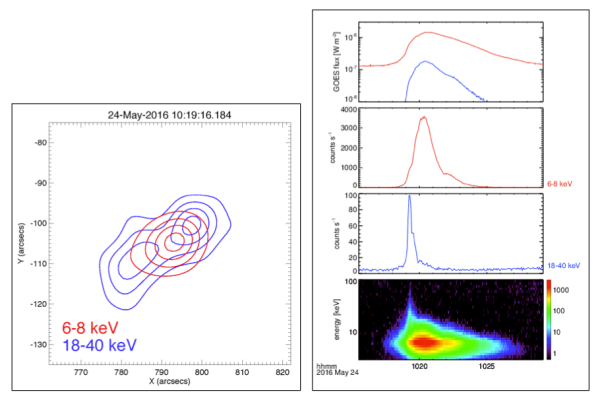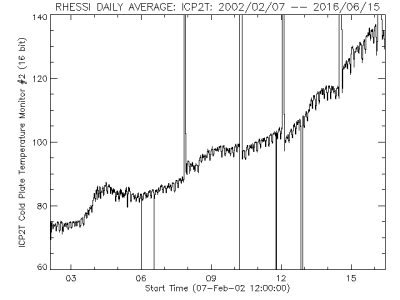RHESSI has resumed operations: Difference between revisions
imported>Hhudson No edit summary |
imported>Bdennis m (Text changes) |
||
| Line 3: | Line 3: | ||
|title = RHESSI has resumed operations | |title = RHESSI has resumed operations | ||
|number = 276 | |number = 276 | ||
|first_author = | |first_author = Albert Shih, | ||
|second_author = Säm Krucker and | |second_author = Säm Krucker and Brian Dennis | ||
|publish_date = 20 June 2016 | |publish_date = 20 June 2016 | ||
|next_nugget = TBD | |next_nugget = TBD | ||
| Line 14: | Line 14: | ||
As described in | As described in | ||
[http://sprg.ssl.berkeley.edu/~tohban/wiki/index.php/RHESSI%27s_5th_Anneal Nugget 269], | [http://sprg.ssl.berkeley.edu/~tohban/wiki/index.php/RHESSI%27s_5th_Anneal Nugget 269], | ||
RHESSI began its 5th anneal cycle on February 23. | RHESSI began its 5th anneal cycle on February 23, 2016. | ||
The annealing process involves raising RHESSI's detectors to an elevated | The annealing process involves raising RHESSI's detectors to an elevated | ||
temperature, during which the | temperature close to 100 degrees C for about 10 days, during which the effects of accumulated radiation damage are significantly reduced. | ||
The data flow was turned off during the annealing operation but was restored starting on 29 April, 2016. Since that time each of the nine detectors have been turned on and their performance tested. Starting on May ???, only detectors 3 and 8 are turned on to allow the lowest operating temperature to be maintained while preserving RHESSI's core capability of X-ray imaging spectroscopy above 3 - 6 keV. | |||
The data flow | Figure 1 shows images of the C1.3 event, SOL2016-05-24T10:20 that illustrate this capability. | ||
was restored | |||
Figure 1 shows images of SOL2016-05-24T10:20 | |||
[[File:276f1ab.png|600px|thumb|center| Figure 1: Left, | [[File:276f1ab.png|600px|thumb|center| Figure 1: Left, RHESSI X-ray images in two spectral | ||
bands of SOL2016-05-24T10:20 (C1.3) | bands of SOL2016-05-24T10:20 (C1.3). Right, GOES and RHESSI light curves and | ||
[http://sprg.ssl.berkeley.edu/~tohban/nuggets/?page=article&article_id=1 RHESSI spectrogram]. | [http://sprg.ssl.berkeley.edu/~tohban/nuggets/?page=article&article_id=1 RHESSI spectrogram of the same flare]. | ||
]] | ]] | ||
Another example | Another example confirms RHESSI's sensitivity to an even weaker event: the B3 flare, SOL2016-06-09T13:25, shown in the quicklook | ||
[http://sprg.ssl.berkeley.edu/~tohban/browser/?show=grth1+qlpcr+qli02+rms4a&date=20160609&time=132455&bar=1 Browser]. | |||
[http://sprg.ssl.berkeley.edu/~tohban/browser/?show=grth1+qlpcr+qli02+rms4a&date=20160609&time=132455&bar=1 | |||
This is a nice microflare with | This is a nice microflare with | ||
[http://solarphysics.livingreviews.org/open?pubNo=lrsp-2006-2&page=articlesu11.html type III] | [http://solarphysics.livingreviews.org/open?pubNo=lrsp-2006-2&page=articlesu11.html type III] | ||
| Line 39: | Line 33: | ||
=== Functionality === | === Functionality === | ||
As the cryocooler ages, the operating | As the cryocooler ages, the detector operating temperature has | ||
continued to increase | continued to slowly increase. | ||
Figure 2 shows this via a | Figure 2 shows this via a plot of the detector "cold plate" temperature | ||
over the full lifetime of RHESSI from launch in 2002 to the present. The gradual increase results from the loss in efficiency of the | |||
The | cryocooler that is expected to continue indefinitely. | ||
cryocooler | |||
[[File:276f2.png|400px|thumb|center| Figure 1: | [[File:276f2.png|400px|thumb|center| Figure 1: Plot covering the full 14 year lifetime of the mission showing the temperature in kelvin (K) of the "cold plate" on which the nine germanium detectors are mounted. | ||
the "cold plate" | The five large positive excursions are at the times of the five anneal | ||
operations to date. | |||
The five large positive excursions are the times of the five anneal | Much of the short-term fluctuations result from periodic variations in the day/night duty cycle. | ||
operations | |||
Much of the short-term | |||
]] | ]] | ||
The | The detector temperature is approaching the point where some detectors lose | ||
[http://sprg.ssl.berkeley.edu/~tohban/nuggets/?page=article&article_id=27 segmentation]. | [http://sprg.ssl.berkeley.edu/~tohban/nuggets/?page=article&article_id=27 segmentation]. | ||
If this happens they will not function so well as gamma-ray spectrometers, because the | If this happens they will not function so well as gamma-ray spectrometers, because the | ||
| Line 68: | Line 59: | ||
Since the detector amplifiers dissipate some tiny amounts of heat in the cryocooler, turning some | Since the detector amplifiers dissipate some tiny amounts of heat in the cryocooler, turning some | ||
of them off can decrease the rate of temperature increase. | of them off can decrease the rate of temperature increase. | ||
Thus we now plan to | Thus, we now plan to keep all but two of the detectors switched off except during times of | ||
high solar activity and for special support activities. | high solar activity and for special support activities. | ||
At the time of writing, we are operating Detectors 3 and 8. | |||
As shown in Figure 1, this still allows us to obtain hard X-ray images, | As shown in Figure 1, this still allows us to obtain hard X-ray images, | ||
time series, and spectra as before, but the images have less | time series, and spectra as before, but the images have less | ||
[http://sprg.ssl.berkeley.edu/~tohban/nuggets/?page=article&article_id=8 (u,v)-plane] | [http://sprg.ssl.berkeley.edu/~tohban/nuggets/?page=article&article_id=8 (u,v)-plane] | ||
coverage. | coverage, limiting the range of angular resolutions to ~7 to ~106 arcsec. | ||
Users of RHESSI observations from this point on should be aware that for most of the time with low and moderate solar activity only two detectors may be operating. | Users of RHESSI observations from this point on should be aware that for most of the time with low and moderate solar activity only two detectors may be operating. | ||
In our new operating scheme, the full complement of detectors will be turned on at times of exceptionally | In our new operating scheme, the full complement of detectors will be turned on at times of exceptionally | ||
high activity, or to support specific observing campaigns. | high solar activity, or to support specific observing campaigns. | ||
These | These will include supporting the new microwave imaging with the Expanded Owens Valley Solar Array (EOVSA), the X-ray imaging observations with NuSTAR, the soft X-ray spectroscopy with the Miniature X-ray Solar Spectrometer (MinXSS) CubeSat recently launched from the International Space Station (ISS), and the first solar observations with the Atacama Large Millimeter/submillimeter Array | ||
[http://www.ssalmon.uio.no ALMA] | [http://www.ssalmon.uio.no ALMA] expected later this year or early next year. | ||
=== The future === | === The future === | ||
RHESSI has returned successfully from its fifth annealing operation | RHESSI has returned successfully from its fifth annealing operation. We are again obtaining data but with a reduced number of operating detectors. While all detectors are operational with four fully segmented, we are limiting the number of detectors that are turned on at any one time in order to reduce the heat load on the cryocooler. In this way we expect to be able to maintain the detector temperature within the necessary operating range and retain the ability to turn on all detectors during any upcoming periods of high solar activity in Cycle 24. At present, we are operating detectors 3 and 8, and find these to be sufficient for RHESSI's unique core mission of hard X-ray imaging spectroscopy. | ||
At present we are operating detectors 3 and 8 | |||
mission of hard X-ray imaging spectroscopy. | |||
Revision as of 15:42, 17 June 2016
| Nugget | |
|---|---|
| Number: | 276 |
| 1st Author: | Albert Shih, |
| 2nd Author: | Säm Krucker and Brian Dennis |
| Published: | 20 June 2016 |
| Next Nugget: | TBD |
| Previous Nugget: | Non-thermal free-bound emission |
Introduction
As described in Nugget 269, RHESSI began its 5th anneal cycle on February 23, 2016. The annealing process involves raising RHESSI's detectors to an elevated temperature close to 100 degrees C for about 10 days, during which the effects of accumulated radiation damage are significantly reduced. The data flow was turned off during the annealing operation but was restored starting on 29 April, 2016. Since that time each of the nine detectors have been turned on and their performance tested. Starting on May ???, only detectors 3 and 8 are turned on to allow the lowest operating temperature to be maintained while preserving RHESSI's core capability of X-ray imaging spectroscopy above 3 - 6 keV. Figure 1 shows images of the C1.3 event, SOL2016-05-24T10:20 that illustrate this capability.

Another example confirms RHESSI's sensitivity to an even weaker event: the B3 flare, SOL2016-06-09T13:25, shown in the quicklook Browser. This is a nice microflare with type III radio emission.
Functionality
As the cryocooler ages, the detector operating temperature has continued to slowly increase. Figure 2 shows this via a plot of the detector "cold plate" temperature over the full lifetime of RHESSI from launch in 2002 to the present. The gradual increase results from the loss in efficiency of the cryocooler that is expected to continue indefinitely.

The detector temperature is approaching the point where some detectors lose segmentation. If this happens they will not function so well as gamma-ray spectrometers, because the anticoincidence between independent front and rear segments will no longer be possible, and the background counting rate will increase substantially. Even without detector segmentation, though, we expect that RHESSI will still perform its core function of hard hard X-ray imaging spectroscopy.
To postpone the loss of segmentation, specifically to be able to observe the last few gamma-ray flares of Cycle 24, we we now plan to operate RHESSI in a low-power mode. Since the detector amplifiers dissipate some tiny amounts of heat in the cryocooler, turning some of them off can decrease the rate of temperature increase. Thus, we now plan to keep all but two of the detectors switched off except during times of high solar activity and for special support activities. At the time of writing, we are operating Detectors 3 and 8. As shown in Figure 1, this still allows us to obtain hard X-ray images, time series, and spectra as before, but the images have less (u,v)-plane coverage, limiting the range of angular resolutions to ~7 to ~106 arcsec. Users of RHESSI observations from this point on should be aware that for most of the time with low and moderate solar activity only two detectors may be operating.
In our new operating scheme, the full complement of detectors will be turned on at times of exceptionally high solar activity, or to support specific observing campaigns. These will include supporting the new microwave imaging with the Expanded Owens Valley Solar Array (EOVSA), the X-ray imaging observations with NuSTAR, the soft X-ray spectroscopy with the Miniature X-ray Solar Spectrometer (MinXSS) CubeSat recently launched from the International Space Station (ISS), and the first solar observations with the Atacama Large Millimeter/submillimeter Array ALMA expected later this year or early next year.
The future
RHESSI has returned successfully from its fifth annealing operation. We are again obtaining data but with a reduced number of operating detectors. While all detectors are operational with four fully segmented, we are limiting the number of detectors that are turned on at any one time in order to reduce the heat load on the cryocooler. In this way we expect to be able to maintain the detector temperature within the necessary operating range and retain the ability to turn on all detectors during any upcoming periods of high solar activity in Cycle 24. At present, we are operating detectors 3 and 8, and find these to be sufficient for RHESSI's unique core mission of hard X-ray imaging spectroscopy.